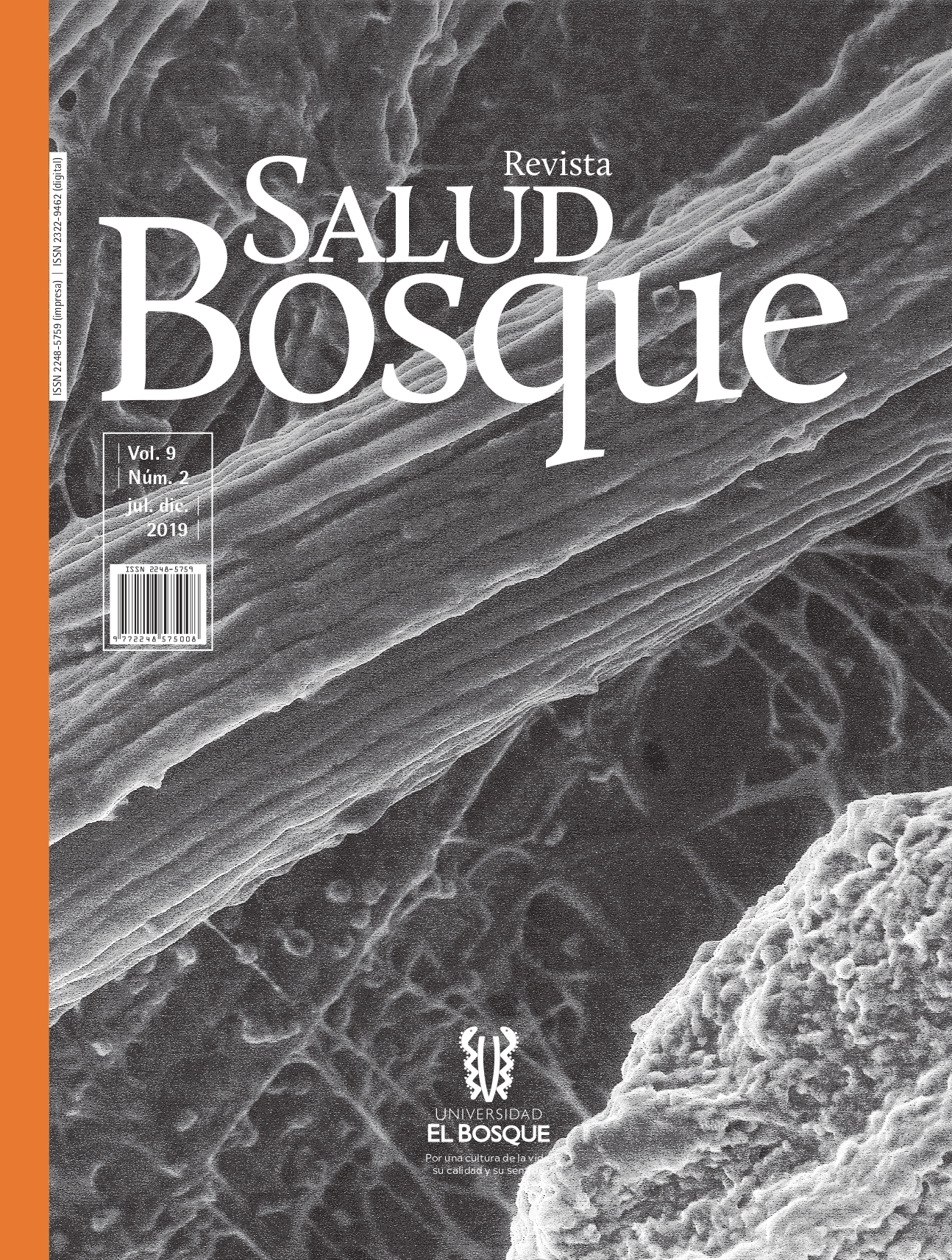Risk Factors in Chronic Diseases – Control with an Active Epidemiological Surveillance System: one step further with the STEPwise model
DOI:
https://doi.org/10.18270/rsb.v9i2.2791Keywords:
Chronic diseases, Non-communicable diseases, Epidemiological surveillance, Risk factors, Public health, Active surveillance, WHO STEPwise modelAbstract
It has long been known that chronic diseases are often the result of prolonged exposure to certain environmental, lifestyle or socio-economic factors. It is also recognized that chronic diseases can be prevented, detected and controlled; but the reality is that the disease profile in a developing country like Colombia demonstrates a large burden of chronic diseases, reflected in most of its communities. This problem is also the result of an erroneous public health approach, focusing on medical treatment for the later stages of the disease, living prevention to a secondary role. At the individual level, a health system like Colombian’s framework do not perform enough work and efforts for early detection and rapid actions to address modifiable risk factors. Individual and population-based measures against chronic disease risk factors are carried out sporadically for some people, but not as a preventive public policy. Therefore, complimenting the need for activities on the determinants of population health, the purpose of this proposal is directed to the management and control of these deficiencies through the implementation of an active surveillance system. Using the World Health Organization step-by-step model as the conceptual framework, this specific surveillance system is established as a new strategy through which health data at the community level can be analyzed, expanded, and integrated into existing general public health surveillance and the infrastructure of the Colombian’s health programs. As a result, this document intends to lay out the foundations for these new strategic tools to inform suitable planning with the adaptation of interventions; aiming at achieving optimal early detection and rapid intervention of risk factors. Closing these gaps should be another step towards reaching a preventive approach to address the enormous burden of chronic diseases for the Colombian population.
Downloads
References
Remington, PL, et al. Chronic Disease Epidemiology, Prevention, and Control, 4th edition, 2016. Publisher: American Public Health Association.
Holt. J, Huston. S, Heidari. K, et al. Indicators for Chronic Disease Surveillance – United States, 2013. MMWR, Recomm and Rep. Centers for Disease Control and Prevention (CDC), 2015, Vol. 64, N. 1
Murray CJL et al. Disability-adjusted life years (DALYs) for 291 diseases and injuries in 21 regions, 1990—2010: a systematic analysis for the Global Burden of Disease Study 2010. The Lancet, Volume 380, Issue 9859, pages 2197 – 2223, 2012. Available in: http://www.thelancet.com/journals/lancet/article/PIIS0140-6736(12)61689-4/abstract#aff6
World Health Organization. Global status report on noncommunicable diseases-2010. (WHO-2011). Available in:http://www.who.int/nmh/publications/ncd_report2010/en/
McQueen, D.V. & Puska, P. (2012, Editors). Global Behavioral Risk Factor Surveillance, 3th edition. Publisher by Springer.
Osorio MA, et al. Así Vamos en Salud. Reporte Anual. El Sistema de Salud Busca su Rumbo. Retos del Sistema de Salud. Capítulo 4, 2012. Available in: http://www.asivamosensalud.org/publicaciones/informe-anual
Organización Panamericana de la Salud – PAHO. Health in the Americas, 2007 report, 2014. Available in: http://www2.paho.org/saludenlasamericas/dmdocuments/health-americas-2007-vol-1.pdf
Knowler. WC, Barrett-Connor. E, Fowler. SE, Hamman. RF, Lachin. JM, Walker. EA, et al. Reduction in the incidence of type 2 diabetes with lifestyle intervention or metformin. New England Journal of Medicine. 2002;346(6): 393-403.
Kannel, WB. New Perspectives on cardiovascular risk factors. American Heart Journal, 1987; volume 114(1 Pt 2), pages: 213-9.
Kannel, WB. New Perspectives on cardiovascular risk factors. American Heart Journal, 1987; volume 114(1 Pt 2), pages: 213-9.
Jama, Multiple Risk Factor Intervention Trial Research Group. Risk factor changes and mortality results. Journal of American Medical Association, 1982; 248(12): 1465-77.
Rothman, K.J. et al. Modern Epidemiology, Chapter 2, Surveillance. Publisher: Scholar Portal Books, 2008
Stephen. B et al. Surveillance, Chapter 3, from Field Epidemiology, third Edition by M. Gregg. Publisher: Oxford University Press, 2008.
McNabb, S. et al. Transforming Public Health Surveillance: Proactive Measures for Prevention, Detection, and Response, 1st Edition. Publisher: Elsevier, 2016.
Davis M. (2009) Public Health Surveillance. University of North Carolina & the North Carolina, Institute for Public Health. Lecture-training series, topic surveillance.
Snider C. Health Care Practitioner Reporting of Infectious Diseases. University of North Carolina & the North Carolina institute for Public Health, 2006. Lecture-training series, topic surveillance.
Kipp A (2004) Reportable Disease Surveillance. University of North Carolina & the North Carolina institute for Public Health. Lecture-training series, topic surveillance.
Public Health Agency of Canada (PHAC, 2015). Ottawa chapter of Health Promotion. An international Conference.
World Health Organization. Noncommunicable diseases and their risk factors. STEPS Manual, 2019. Available in: https://www.who.int/ncds/surveillance/steps/STEPS_Manual. pdf?ua=1
Lopera V. & Santacruz E. Risk factors associated with chronic non-communicable diseases in Medellin in. Assessment with the stepwise survey methodology. Revista de Salud Pública de Medellín, 2012. Volume 5, number 2.
Secretaría de Salud de Santander - Observatorio de Salud Pública de Santander (2011). Factores de riesgo para enfermedades crónicas en Santander, método STEPwise. Bucaramanga– Colombia. Available in: http://www.who.int/chp/steps/2010_STEPS_Survey_Colombia.pdf
Gregg, MB. (2008). Field Epidemiology. Chapter #3, Surveillance.Publisher: Oxford University Press.
Stephen. B et al. Surveillance, Chapter 3, from Field Epidemiology, third Edition by M. Gregg. Publisher: Oxford University Press, 2008.
Centers for Disease Control and Prevention (1997). Case definition for public health surveillance. Morb Mortal Wkly Report 46, (RR-10) 1-55.
World Health Organization. STEPS conceptual framework, view of the instruments at a glance, WHO-2014. Available in: http://www.who.int/chp/steps/framework/en/
Thonson NJ, McClintoch HO. National Center for Injury Prevention and Control, Centers for Disease control and Prevention, Atlanta, GA: Demonstrating Your Program’s Worth: A primer on Evaluation for Programs to Prevent Unintentional Injury, 1998, pages 21-22.
ESRI-GIS, (2019). ESRI Home, available in: http://www.esri.com/
Así Vamos en Salud. Indicadores de salud y enfermedad, 2019. Available in: https://www.asivamosensalud.org/
Pulido A. (2009). Así Vamos en Salud, Reporte Anual. Tendencias de Salud en Colombia. Available at: http://www.asivamosensalud.org/publicaciones/informe-anual
Así Vamos en Salud. Indicadores de salud y enfermedad, 2019. Available in: https://www.asivamosensalud.org/
Osorio MA, et al. Así Vamos en Salud. Reporte Anual. El Sistema de Salud Busca su Rumbo. Retos del Sistema de Salud. Capítulo 4, 2012. Available in: http://www.asivamosensalud.org/publicaciones/informe-anual
World Health Organization. Health Promotion. The Ottawa Charter for Health Promotion, 2019. Available in: https://www.who.int/healthpromotion/conferences/previous/ottawa/en/
Public Health Agency of Canada. Chronic Disease Facts and Figures; Economic Burden of Illness, 2014. Available in: http://www.phac-aspc.gc.ca/cd-mc/facts_figures-faits_chiffres-eng.php
Alwan, A., et al. Monitoring and surveillance of chronic non-communicable diseases: progress and capacity in high-burden countries. The Lancet, 2010, volume 376, issue 9755, pages: 1861-1868.
World Health Organization. Closing the Gap in a Generation: Health Equity through Action on the Social Determinants of Health. Final Report on the Commission on social Determinants of Health. Geneva: WHO-2008. Available in: http://www.who.int/social_determinants/thecommission/finalreport/en/
Snider C. Health Care Practitioner Reporting of Infectious Diseases. University of North Carolina & the North Carolina institute for Public Health, 2006. Lecture-training series, topic surveillance.
Ministerio de Salud. Resolución Número 00412. “Por la cual se establecen las actividades, procedimientos e intervenciones de demanda inducida y obligatorio cumplimiento y se adoptan las normas técnicas y guías de atención para el desarrollo de las acciones de protección específica y detección temprana y la atención de enfermedades de interés en salud pública”. Diario Oficial. Año CXXXV, No. 49956, viernes 31 marzo de 2000.
Public Health Agency of Canada – (PHAC, 2014). Surveillance Programs, available in: http://www.phac-aspc.gc.ca/surveillance-eng.php
Downloads
Published
How to Cite
Issue
Section
License

This work is licensed under a Creative Commons Attribution-NonCommercial 4.0 International License.
The authors will submit a statement attesting to the authenticity of the material, attaching signature and id number. It is also required that they submit a statement surrendering economic rights to El Bosque University










